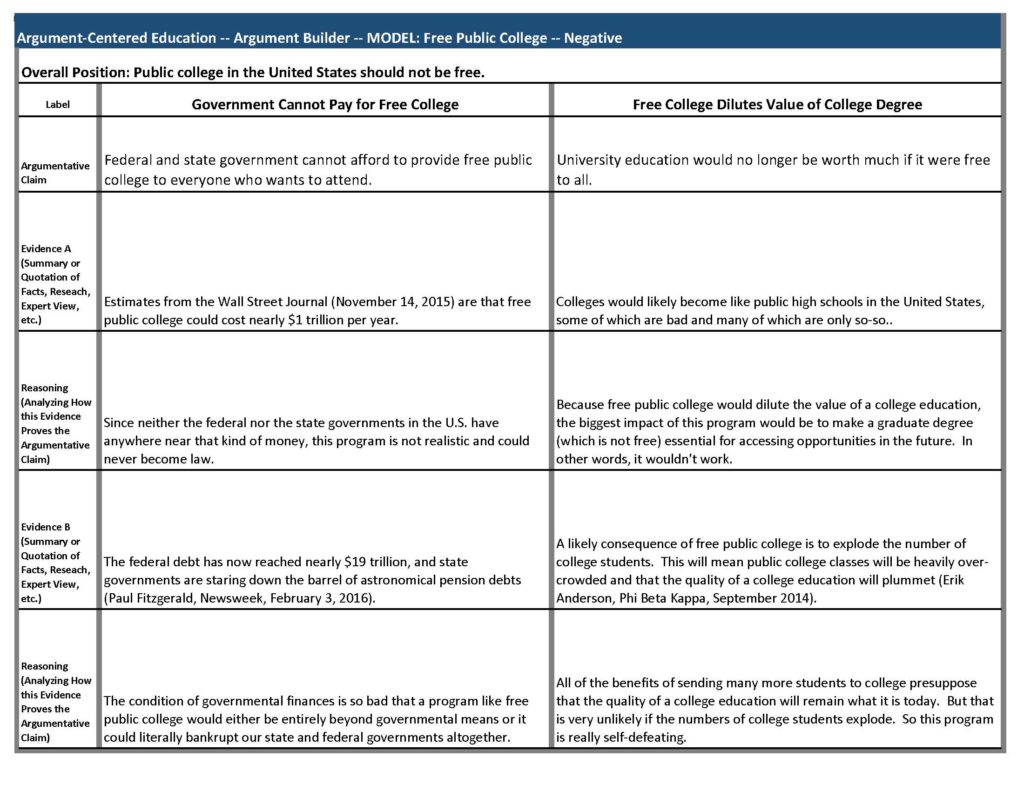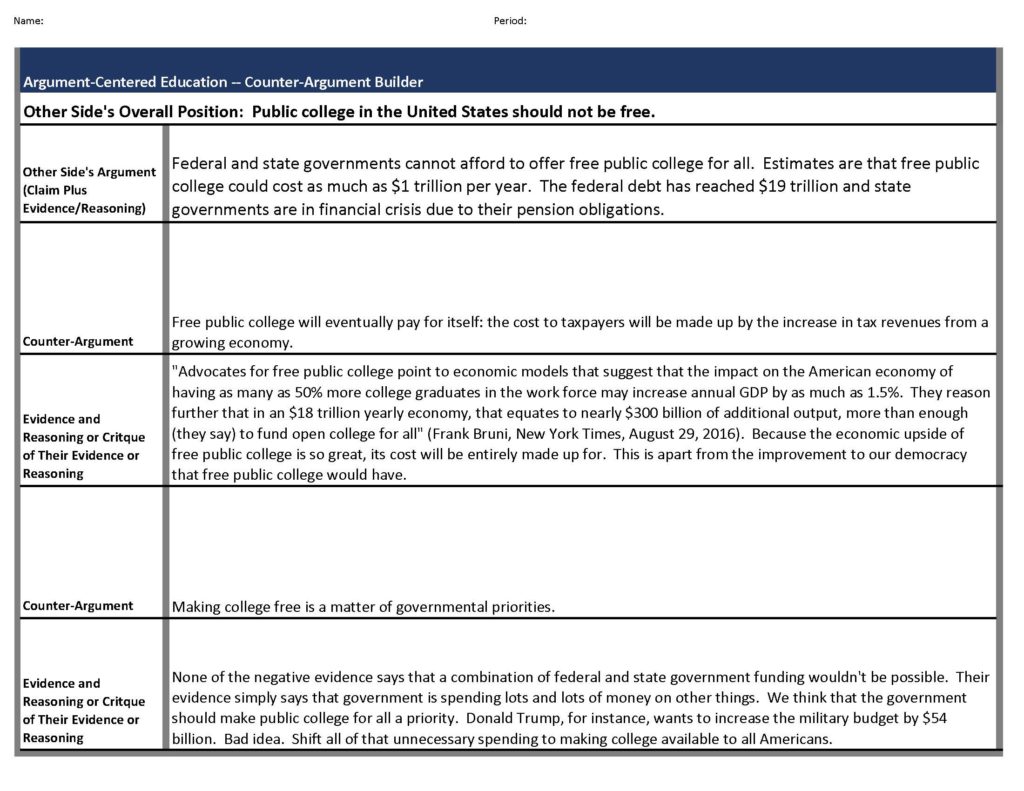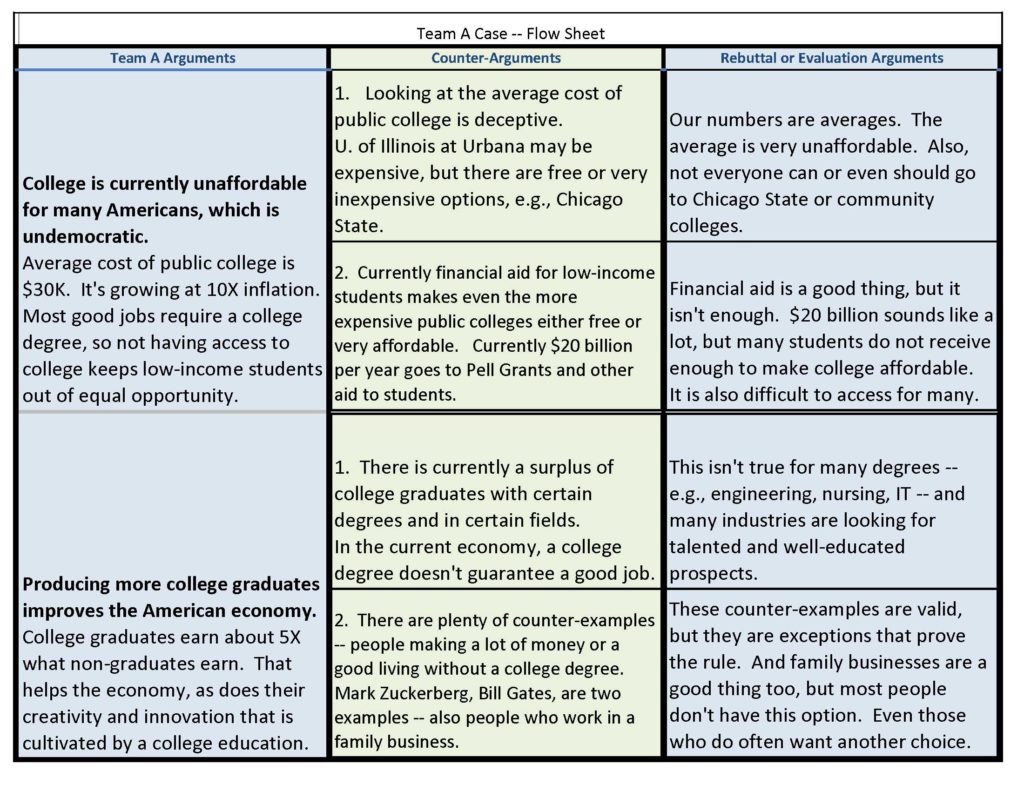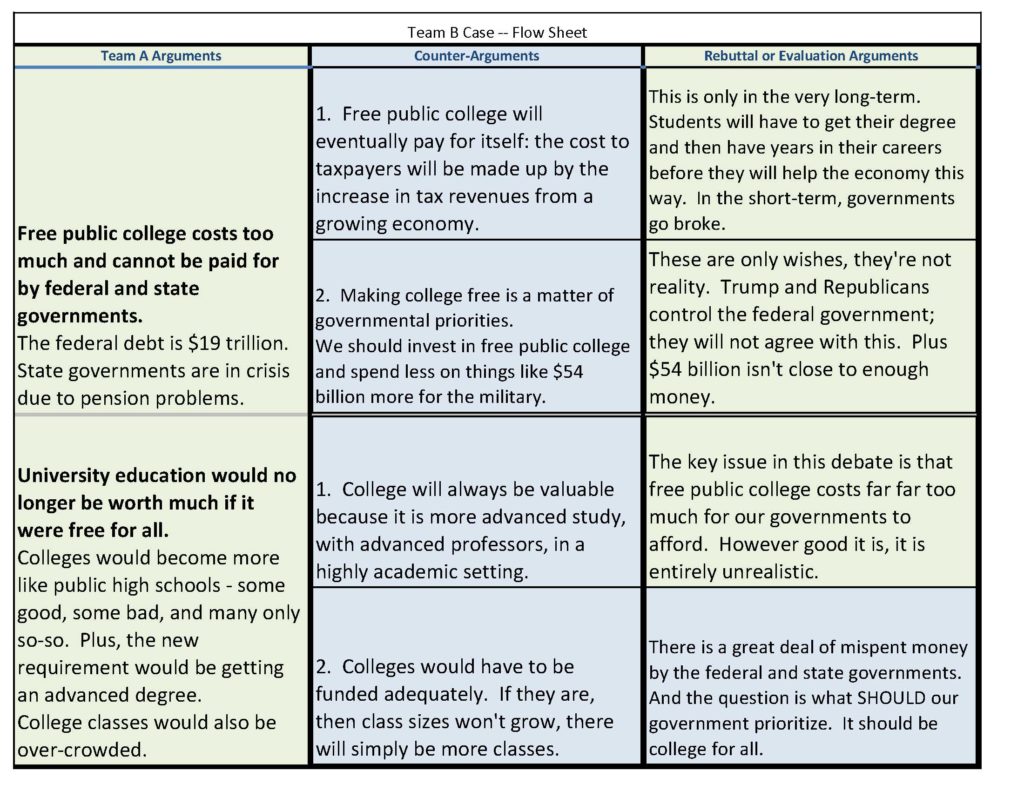
Argument Models: A Prerequisite Resource in Effective Argument-Based Instruction
Overview
Here is a simple but profound and universally true pedagogical rule that we have (not invented but) discovered: Whatever the kind of argument-based instructional activity, lesson, or assessment you are working with, it is an essential prerequisite for its effective implementation to develop and present to students modeling resources. Along with prompt, specific, and improvement-directed feedback, modeling may be the most useful tool in the pedagogical toolkit.
Many, probably most, varieties of argument-centered projects, activities, lessons, and assessments require students to build arguments and counter-arguments, and they require that students track arguments carefully on a flow sheet so that they know what arguments have been made by both sides, how (and whether) those arguments have been responded to, and how the argumentation is developed and can be weighed and evaluated. (Tracking arguments is crucial if we are to bring our students into a closer and at the same time more objective relationship with the arguments they make, hear, read, and respond to.)
We need models for each of these components of an argument-based project. And we need to present and review models in the early stage of every argument-based unit of curriculum we implement, until students have so extensively assimilated these forms that further modeling is redundant. At this stage, we’d be better served by asking students to consider creating their own alternative argument design models, breaking our molds to create their own. But this is down the line for most of our students. In the vast majority of classroom situations that we work within, students still learn from — or are reaffirmed and made more self-confident in their understanding by — “standard” models of argument, counter-argument, and flow sheets.
Teachers who are bringing argument into the center of their instruction should be thinking through and developing their own models of these argumentation components. The most effective models will be subject area specific, and tailored to their students’ learning level, balancing our interest in stretching students’ academic competencies up without over-stretching and creating an inaccessible model. Best-practice models will try to parallel unit content that students are arguing about, but not incorporate that exact content, since we do not want students to simply replicate a model; rather, they should assimilate the qualities that make the model effective and apply those qualities to the parallel instance of the argumentation that they are being asked to produce. One footnote, here (and to say that is not to trivialize it in any way: this is an important practical point): models do not need to be researched. Models can perform the very same heuristic function if you make up the evidence in the fields, with the important proviso that you tell students that the evidence has been fabricated.
All of this is to describe the ideal. Our classroom instruction does not always reside in the ideal state, however. Teachers often have to apply models that are more generic, more standard, losing a little bit of tailored applicability but retaining the demonstration of the qualities that make for effective performance in the several argumentation components that I’ve referenced in this post. And further, teachers themselves need to have modeling modeled: they benefit from seeing examples of effective models in order to attain the capacity to design their own.
So this post comprises argumentation models that teachers can both learn from and use in their classrooms. They are on the issue
Should public college in the United States be free?
This is an issue that we have been working with partner schools on this school year, in several different academic contexts, as we discussed in a prior Debatifier post, including a school-wide beginning of year, middle of year, end of year argument writing assessment. Given all that we’ve said already about applicability and adaptability, it probably now goes without saying that these models are usable regardless of the content or even subject areas that are actually being taught.
Models: Argument Builders


Comments on these models
This particular argument builder form has two arguments on a single page. We have more often been using the argument builder version that has a single argument on a single page, simply to give students who are writing in hard copy (rather than using the electronic versions) more space to write.
All writing on the argument builder and counter-argument builder should be in complete, grammatical sentences, with the exception of the “labels” which are deliberately short-hand, 4 – 6 word phrases that enable students to reference an argument in a paper or in a debate without having to repeat the entirety of the claim.
One important reason to write in full sentences this way is that the argument and counter-argument builders should be understood as a full and important part of the argument writing process. When done properly and done well, these builders contain a substantial portion of the content of an argument essay or paper that they prepare students to write. Much of the writing, in fact, is done on these graphic organizers.
Evidence in the builders should be cited, but the form of the citation can vary. Looking at the argument builder for the negative, there is a good example of two forms of citation. In the first piece of evidence (Evidence A) for the first argument (government cannot pay for free college), the source (Wall Street Journal) of the evidence is embedded in the presentation of the evidence itself, with only the date in parenthesis coming after the source. In the second piece of evidence (Evidence B) for the second argument (free college dilutes the value of a college degree), the paraphrased passage from the source is followed by the parenthetical citation. Both of these forms are equally valid, and stylistic variation (as much as anything) can explain a preference for one over the other in any given writing or speaking situation.
The two pieces of evidence for a single argument both need to support the claim, so they will necessarily be closely related and, in that respect, similar, but they should never say exactly the same thing, and they should never be redundant. A particularly good example of two pieces of evidence working in complementarity can be found on the affirmative argument builder, in the second argument (college improves the U.S. economy). Evidence A says that college graduates earn considerably more than those who do not graduate from college. But though that evidence is suggestive, it doesn’t necessarily go the full distance to support the claim that the American economy as a whole will benefit from having more college graduates in the workforce. So the second piece of evidence comes at the matter from another angle and explains that the college graduates can be more innovative and creative in their problem-solving in the workplace, improving their companies’ productivity in consequence. Both pieces of evidence support the argumentative claim, in an extending, mutually reinforcing way and not redundantly.
Reasoning should provide impact to arguments; it should (in the three-step reasoning sequence of accent – connect – emphasize, that we recommend to teach students the difficult skill of reasoning through the way that evidence supports a claim) emphasize the importance of the evidence to the argument and of the argument to the overall position (or thesis). A very good example of the way reasoning can perform this task is the first argument (college is unaffordable) on the affirmative argument builder. The second piece of reasoning is direct about it matters so much that a college degree is a prerequisite to most middle and upper-middle class jobs in America: the consequence of limiting access to college to only the affluent means then that America will no longer offer equal opportunities to all, and will very unfairly limit opportunities for professional success to those born to affluence already.
Models: Counter-Argument Builders


Comments on these models
There are two types of counter-argument: “independent” and “critical.” Each counter-argument builder demonstrates one of each. The affirmative model responds to the argument that government cannot afford to offer free public college to all. It makes two counter-arguments to this argument. The first is independent. It includes its own evidence and reasoning that attempts to contradict or undercut the argument. In this instance, it is evidence from the New York Times that says that the cost of paying for millions of students’ tuition will be offset by the gains in the economy that all of these additional college graduates in the American workforce will produce. The second counter-argument is critical. It critiques the evidence and reasoning in the original argument, it does not present new evidence. So, in this instance, the critical counter-argument says that even though free public college would be expensive, paying for it is a matter of governmental priorities, and the U.S. would be better off paying for free public college and not paying for a massive increase in the military budget, as proposed by the Trump administration.
Note that the counter-argument builder asks for the other side’s overall position and a summary of the other side’s argument argument. Then it asks for two counter-arguments to this one argument. The implication is that, for this table debate, teams will need two counter-argument builders so that they can address both of the other side’s two case arguments.
Evidence and reasoning for each counter-argument is to be written in the same field. A particularly good example of the sequenced combination of both evidence and reasoning can be found in the second counter-argument on the negative side’s counter-argument builder. In that space on the form, the model has a strong quotation from the National Interest to the effect that there is substantial financial aid provided to in-need students currently. Then the reasoning attaches that evidence to the affirmative’s argument that college is unaffordable by explaining that discussion in the affirmative side’s evidence of the “sticker price” of college overlooks the substantial and extensive financial aid that is currently available to lower-income families of prospective college students.
Models: Flow Sheets


Comments on these models
Argument-Centered Education has discovered and owns this as a pedagogical conviction: flowing (i.e., tracking) arguments is of the utmost importance, if we are to help students advance in their argumentation and critical thinking skills. Teachers should be flowing arguments in all structured argumentation activities and debates, to demonstrate and reinforce the practice. And students should be required to practice this difficult technical skill: they will get better and will eventually enjoy their competency, though they will resist at first.
What is flowed? No one can (or should) transcribe every word from a speech or written argument, as they are tracking it on a flow sheet, so what should our students write down? The simple answer — and it is largely, most of, the truth — is this: the claims and counter-claims. Every argument has a surface, a skin, and the substance underneath that warrants and supports that surface. Flowing tracks the surface mainly, as a short-hand for what is happening in the debate or developed argumentation. More advanced, more practiced, annotators of argumentation (i.e., flow-ers) can begin to get some of that backing — some of the evidence and analysis underneath. But it is not essential, and it is typically accessible by recall, IF argumentative claims and counter-claims are on paper.
This flow sheet tracks argumentation in the Table Debates format, which has each side presenting a two-argument case for and against the proposition up for debate — that public college in the U.S. should be free — followed by counter-arguments from each side against the other side’s case arguments. Then there is a final rebuttal from each side, which attempts to refute the counter-arguments and evaluate the argumentation overall in such a way that favors their side.
The rebuttal doesn’t have to “extend” both of the original case arguments. Extending one or the other is often a more effective strategy, as long as it is sufficient to support the overall position (which it will if it is properly formed in the first place), and it is more truly reflective of the evolution of the argumentation in a debate. In other words, it is often the case that with a balanced issue, not all of the arguments for one side or another are sustainable in the face of counter-arguments. An instance of this concession of one of the case arguments, while the rebuttalist extends the other argument is in the negative case flow sheet above. The negative rebuttalist extends the argument that free public college costs too much for the government to pay for, and concedes the argument that the value of a college degree would be diluted.


The model of the expected outcome is a great resource for helping my students with knowing what exactly is involved with building a solid argument.
Yes! Thanks for the note, Alana.